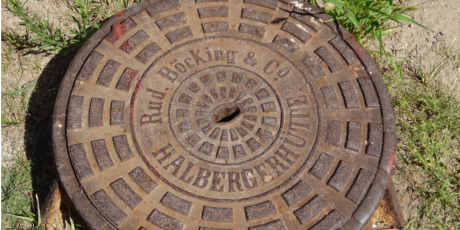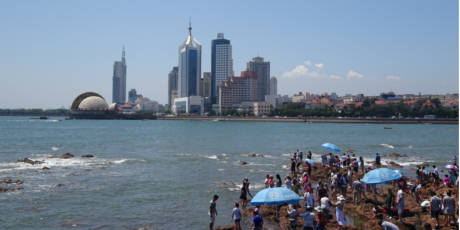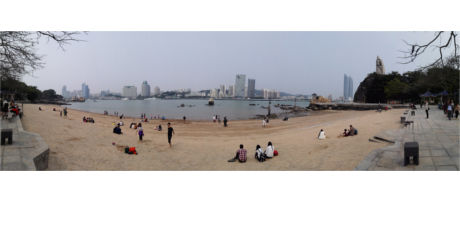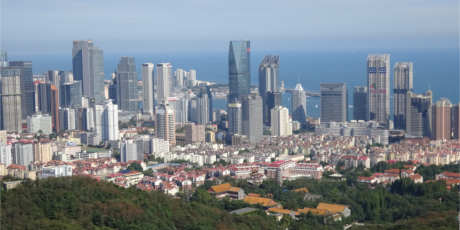Introduction
Qingdao (青岛) is located within around 6,5 hours by high-speed train in the North of Shanghai. The 7,3 million metropolis, which is relatively small by Chinese standards, is subdivided into a modern city ring, as well as – and this is what is special about Qingdao – a German colonial city ring because from 1898 until 1919, the city belonged to the German Empire. Many buildings from that time, fortunately, remained preserved, giving Qingdao a special charm. Such are for example a brewery, a central station, a protestant church, the residence of the governor which is well worth seeing, a former German jail, several fortresses from World War 1, as well as many private buildings and mansions.
Qingdao is an ideal travel destination for a long weekend since most tourist attractions are within walking distance from each other. It is quite interesting to see and experience these former German buildings in a today’s Chinese context. Present-day residents of Qingdao are fully aware of the history of the town and, by now, are also very proud of it. A dedicated effort is made to preserve, honor and pass on the history of the town. The appreciation for German architectural style has now gone so far as many development areas are built based on this particular German style, which means building apartment buildings rather than following the Chinese trend of building skyscrapers.
Time and again, you hear from Qingdao citizens how much they appreciate the German quality of their architecture and products. Also, plenty of times you will be informed about how good the sewer system is in Qingdao. You will be told that no other system in China compares to this one because it was designed by Germans.
Museums and other Attractions worth seeing
Today, many historical buildings are open to the public and often times host small museums or exhibitions. The former residence of the German governor is something no visitor should miss; even Mao resided there once. After that, a visit to the Lutheran church (基督教堂, Jidu Jiaotang) is something worth your while; this church was built in the Wilhelmistic style and often serves as a perfect background for wedding pictures. After having enjoyed the panorama from the bell tower, your next stop should be St. Michael’s Cathedral (圣弥爱尔大教堂; Shèng Mí’ài’ěr Dàjiàotáng), where you certainly will meet more wedding couples. From the Cathedral you will find a straight way to the beach. Here, it is recommended to visit the former German jail, which was later used by the Japanese Empire, as well as by the Chinese after that. Today, the former jail hosts an interesting exhibition, which also depicts the horrors of this place. The Navy Museum of the Republic of China also gives visitors a good overview of the naval forces, even if the focus lies on the time of the cold war.
At one time, Qingdao was also called “Naples of the Yellow Sea”. Capture this attitude towards life which can still be seen and felt today, walking along the boardwalk, on the long pier (Zhan Bridge栈桥), which adorns the logo of Tsingtao beer, or through the historical villa district Badaguan Scenic Area (八大关景区).
Parks
The Zhongshan Park (中山公园) is a spacious green area that is towered by the Qingdao TV Tower. Under good weather conditions, a visit is highly recommendable, since the panoramic view over the old and new Qingdao is something worth experiencing.
For those interested in military history, a visit to Qingdaoshan Park (青岛山公园) should be on the to-do-list. Here, one can still see the far reaching fortresses and bunkers from the German colonial period.
Not far from the residence, the Signal Mountain Park (信号山公园) invites visitors on a stroll, as well as to a wonderful panoramic view over the old city.
Food and Beverages
The coastal metropolis is of course well-known worldwide for its beer with the name Tsingtao, which has its roots in the German colonial period. The brewery can still be visited today and people can taste the different beer types directly on-site. It is also recommendable to taste the Tsingtao beer the traditional way, even if it might seem odd: from a plastic bag with a straw. Visit the port wine museum near the beer brewery, which has been integrated into a large former civil bomb shelter from the time of the cold war.
During your stay in Qingdao, you should not miss out on some of the best seafood of the Shanghdong cuisine (山东菜 Shāndōng cài). Because of the many fishing villages in the area, the fish and seafood is brought to the restaurants daily fresh.
Dishes such as the Chili Sauteed Clams (辣炒蛤蜊Là chǎo gélí), Cold Pasta ‘Liangfen’ (凉粉Liángfěn), as well as Seafood Noodles (海鲜卤面 Hǎixiān lǔ miàn) are highly recommendable. You can also choose your fish or seafood directly from the fish tanks in the restaurant, which will then be prepared freshly for you. Enjoy a fresh, cool Tsingtao beer with your food.
Interesting
Through an annually held selection, Qingdao was elected the most livable city in mainland China in 2009. Also, the Chinese Institute for Competitiveness determined in 2012, that Qingdao was the luckiest city in China. You shouldn’t miss out on visiting this exciting and unique city.
German Loanwords
One of the few German loanwords in Chinese is the word for manhole cover (German: “Gullydeckel”, Chinese: 雨水口 yushuikou, which roughly translates to rainwater hole). In Qingdao – in derogation to the rest of China – it is called “guli” (骨沥). The Chinese learned about manhole covers – or gullys – through the introduction of the sewer system in Jiaozhou, a then leased territory by the Germans. The around 40 German loanwords, that are still used in Qingdao today, include for example the word 大嫚 “daman”, German “Damen”, which means Ladies. Also, the word “Aspirin” is known by the name of Namen 阿司匹林 (āsīpǐlín).
 INT
INT 




